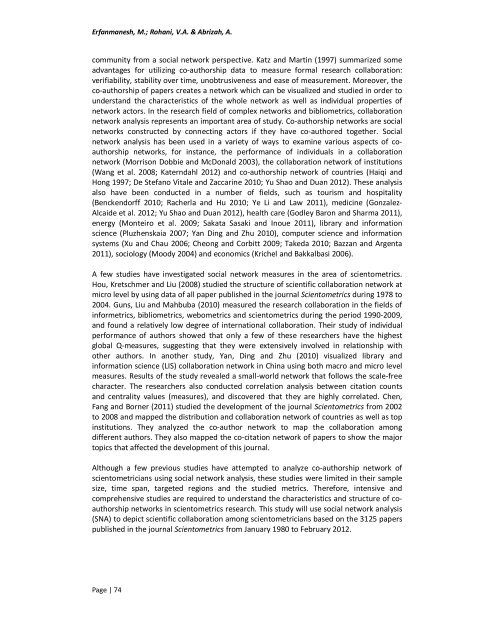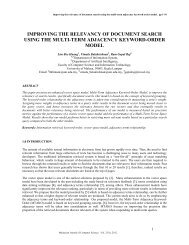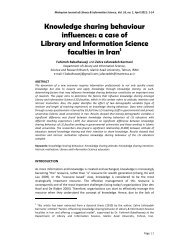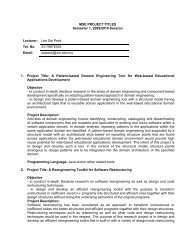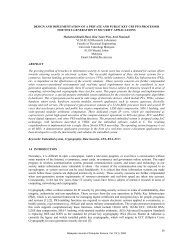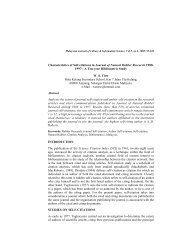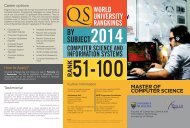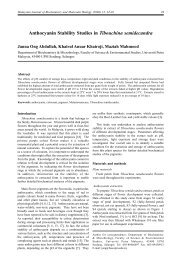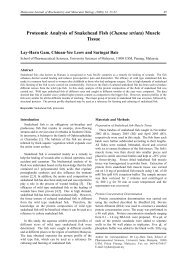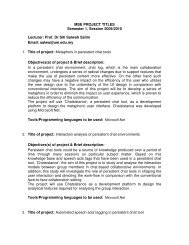Co-authorship network of scientometrics research collaboration - E-LIS
Co-authorship network of scientometrics research collaboration - E-LIS
Co-authorship network of scientometrics research collaboration - E-LIS
- No tags were found...
Create successful ePaper yourself
Turn your PDF publications into a flip-book with our unique Google optimized e-Paper software.
Erfanmanesh, M.; Rohani, V.A. & Abrizah, A.community from a social <strong>network</strong> perspective. Katz and Martin (1997) summarized someadvantages for utilizing co-<strong>authorship</strong> data to measure formal <strong>research</strong> <strong>collaboration</strong>:verifiability, stability over time, unobtrusiveness and ease <strong>of</strong> measurement. Moreover, theco-<strong>authorship</strong> <strong>of</strong> papers creates a <strong>network</strong> which can be visualized and studied in order tounderstand the characteristics <strong>of</strong> the whole <strong>network</strong> as well as individual properties <strong>of</strong><strong>network</strong> actors. In the <strong>research</strong> field <strong>of</strong> complex <strong>network</strong>s and bibliometrics, <strong>collaboration</strong><strong>network</strong> analysis represents an important area <strong>of</strong> study. <strong>Co</strong>-<strong>authorship</strong> <strong>network</strong>s are social<strong>network</strong>s constructed by connecting actors if they have co-authored together. Social<strong>network</strong> analysis has been used in a variety <strong>of</strong> ways to examine various aspects <strong>of</strong> co<strong>authorship</strong><strong>network</strong>s, for instance, the performance <strong>of</strong> individuals in a <strong>collaboration</strong><strong>network</strong> (Morrison Dobbie and McDonald 2003), the <strong>collaboration</strong> <strong>network</strong> <strong>of</strong> institutions(Wang et al. 2008; Katerndahl 2012) and co-<strong>authorship</strong> <strong>network</strong> <strong>of</strong> countries (Haiqi andHong 1997; De Stefano Vitale and Zaccarine 2010; Yu Shao and Duan 2012). These analysisalso have been conducted in a number <strong>of</strong> fields, such as tourism and hospitality(Benckendorff 2010; Racherla and Hu 2010; Ye Li and Law 2011), medicine (Gonzalez-Alcaide et al. 2012; Yu Shao and Duan 2012), health care (Godley Baron and Sharma 2011),energy (Monteiro et al. 2009; Sakata Sasaki and Inoue 2011), library and informationscience (Pluzhenskaia 2007; Yan Ding and Zhu 2010), computer science and informationsystems (Xu and Chau 2006; Cheong and <strong>Co</strong>rbitt 2009; Takeda 2010; Bazzan and Argenta2011), sociology (Moody 2004) and economics (Krichel and Bakkalbasi 2006).A few studies have investigated social <strong>network</strong> measures in the area <strong>of</strong> <strong>scientometrics</strong>.Hou, Kretschmer and Liu (2008) studied the structure <strong>of</strong> scientific <strong>collaboration</strong> <strong>network</strong> atmicro level by using data <strong>of</strong> all paper published in the journal Scientometrics during 1978 to2004. Guns, Liu and Mahbuba (2010) measured the <strong>research</strong> <strong>collaboration</strong> in the fields <strong>of</strong>informetrics, bibliometrics, webometrics and <strong>scientometrics</strong> during the period 1990-2009,and found a relatively low degree <strong>of</strong> international <strong>collaboration</strong>. Their study <strong>of</strong> individualperformance <strong>of</strong> authors showed that only a few <strong>of</strong> these <strong>research</strong>ers have the highestglobal Q-measures, suggesting that they were extensively involved in relationship withother authors. In another study, Yan, Ding and Zhu (2010) visualized library andinformation science (<strong>LIS</strong>) <strong>collaboration</strong> <strong>network</strong> in China using both macro and micro levelmeasures. Results <strong>of</strong> the study revealed a small-world <strong>network</strong> that follows the scale-freecharacter. The <strong>research</strong>ers also conducted correlation analysis between citation countsand centrality values (measures), and discovered that they are highly correlated. Chen,Fang and Borner (2011) studied the development <strong>of</strong> the journal Scientometrics from 2002to 2008 and mapped the distribution and <strong>collaboration</strong> <strong>network</strong> <strong>of</strong> countries as well as topinstitutions. They analyzed the co-author <strong>network</strong> to map the <strong>collaboration</strong> amongdifferent authors. They also mapped the co-citation <strong>network</strong> <strong>of</strong> papers to show the majortopics that affected the development <strong>of</strong> this journal.Although a few previous studies have attempted to analyze co-<strong>authorship</strong> <strong>network</strong> <strong>of</strong>scientometricians using social <strong>network</strong> analysis, these studies were limited in their samplesize, time span, targeted regions and the studied metrics. Therefore, intensive andcomprehensive studies are required to understand the characteristics and structure <strong>of</strong> co<strong>authorship</strong><strong>network</strong>s in <strong>scientometrics</strong> <strong>research</strong>. This study will use social <strong>network</strong> analysis(SNA) to depict scientific <strong>collaboration</strong> among scientometricians based on the 3125 paperspublished in the journal Scientometrics from January 1980 to February 2012.Page | 74


